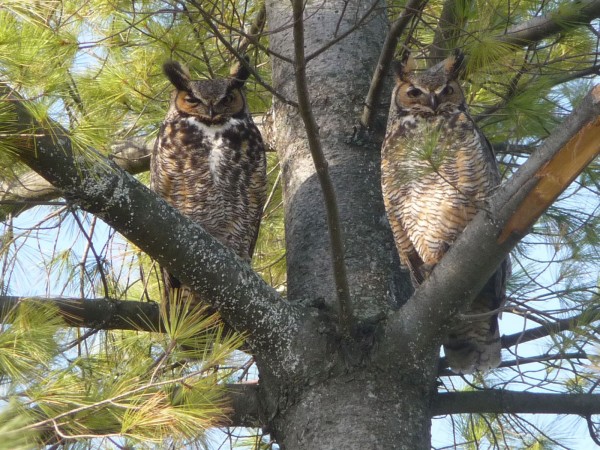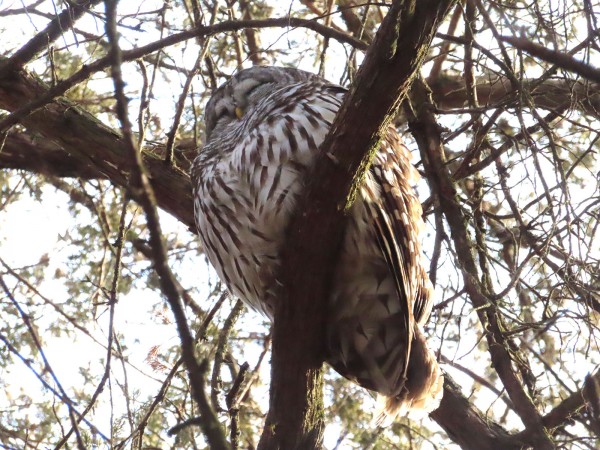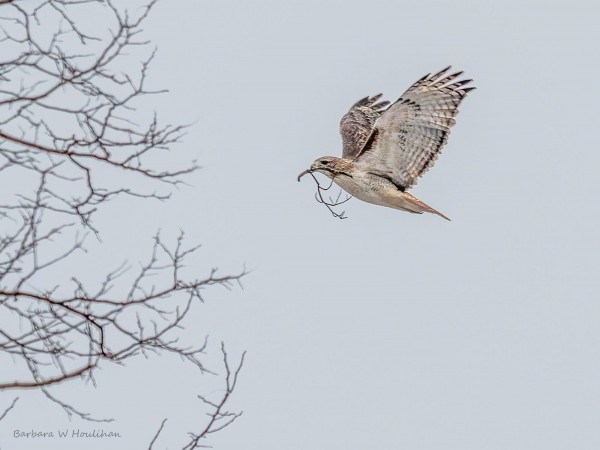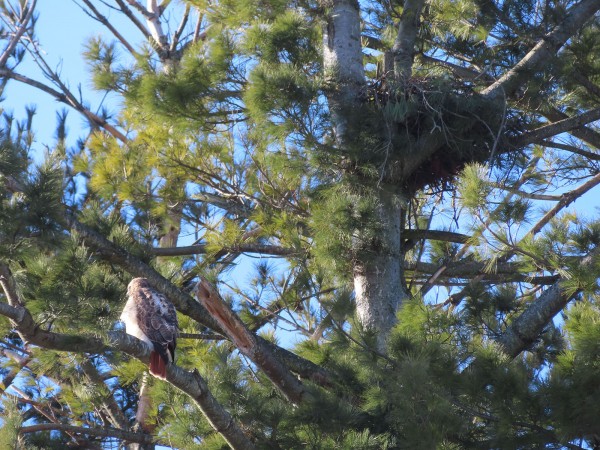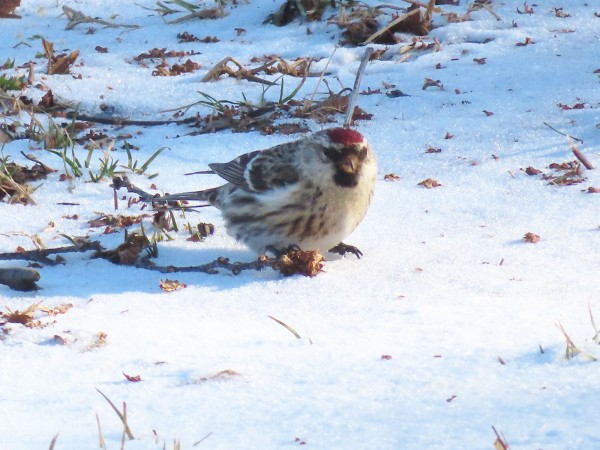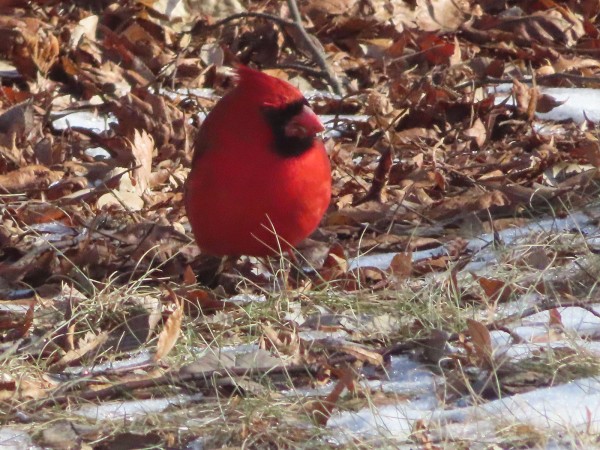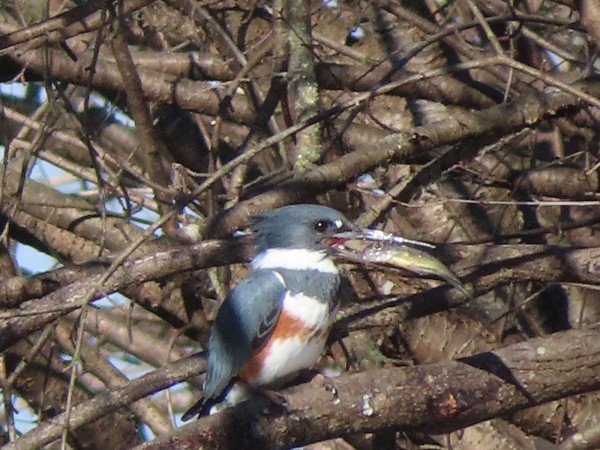Chuck's Birding Report #101
15 February - 21 February 2022
Dear fellow flock of birders,
So what are the birds doing in the Arboretum these days? Luckily they don’t have to walk on the trails.
I think I will focus on three species in this report and those are the species that are either laying eggs right now or preparing to do so by finding a place to nest or building/repairing a nest. Those species are the Great Horned Owl, the Barred Owl and the Red-tailed Hawk.
I showed a photo of the Great Horned Owl that I saw perched in a Spruce Tree in the Pinetum last week. They should be nesting by now and even laying eggs too. I don’t know where their nests are in the Arboretum but my guess would be in the Lost City Forest or on the Grady Tract in the pine forest area. Those are two areas where I’ve heard the hooting of Great Horned Owls. They most often use the nests that other birds build like Red-tailed Hawks and American Crows. Of the species mentioned above they are the earliest to lay their eggs. The eggs incubate for 33-37 days so should hatch in the middle of March. I have included a photo of a pair of Great Horned Owls that had a nest on the north side of the Natatorium about 10 years ago. They produced two owlets. I think it is the best photo I’ve ever seen of a male and female perched beside each other. Students walking by that area could see both the adults and young. There were several of us taking photos and sharing them with each other. I did not take this photo nor do I know who took it so I’m saying the photographer is unknown.
The Barred Owl we see occasionally perched in a Juniper in Juniper Knoll. They start nesting and laying eggs about a month later than Great Horned Owls. Incubation is 28 to 33 days so hatching is in early April. I’m not sure where they nest in the Arb but again my guess would be in Lost City Forest. Several years ago they had a nest in Wingra Woods and had two young. Barred Owls nest in tree cavities. It was fun to watch the adults enter the cavity to feed the nestlings and also to watch the fledglings in their fluffy plumage move around the woods. I did see a Barred Owl in a large hole in a tree located at Picnic Point just up the service road beyond the stone gate. The hole is huge and has been used in the past by Barred Owls. Next time you go to Picnic Point look for the hole on the left side of the road. Hopefully the Barred Owls will be successful in raising young. Look for the young in April. included is a photo of a Barred Owl in Juniper Knoll.
We are beginning to see a pair of Red-tailed Hawks repairing their nest from last year in the White Pine stand just northeast of the Visitor Center. I assume it is the same pair from last year that raised two young in that nest. We’ve seen the pair carrying sticks to the nest to help rebuild it. Last we saw one of the Red-tailed Hawks in the nest and then two came flying out. A couple days ago as I approached the nest I saw the two adults perched side by side near the nest. As I got closer one flew away so I didn’t get a photo of the pair. They build their own nests and lay eggs in the second or third week in March. The incubation period is about 35 days so hatching should be in the middle of April sometime. Included are several photos of Red-tailed Hawks. The best one is a photo of a flying Red-tailed Hawk carrying a stick to the nest. The photo was taken by one of our birders who is a great photographer. She is Barbara Houlihan and she kindly agreed to share her photo from last week with us for this report. Look at the beautiful detail. Thank you Barbara! The other two photos I took of the Red-tailed Hawks in and around the nest.
The next three photos are of birds that are common in and around the Arboretum.
The Common Redpolls are still feeding on the seeds of the Sweet Birches near the Crabapple Collection. Yesterday they were not feeding up in the trees but instead on the ground. There were many seeds that had fallen out of the catkins and were easily available on the ground. Included is a photo of a Common Redpoll feeding on the ground.
Northern Cardinals are still singing and announcing the coming of spring. (I wish it would come sooner rather than later. I’m tired of WWW or Wisconsin Winter Whiplash.) Included is a photo of a male Northern Cardinal feeding on the ground too.
Down at the Big Spring the Belted Kingfisher has been feeding on fish from the outflow of the spring. On Sunday, one of those nice 40 or more degree days in the Arb many families were walking by the spring. I was able to show them the Belted Kingfisher and tell them the story of how they catch fish by flying over the water and diving into the water to catch a 3-4 inch long fish. One family of two adults and three children actually got to see this. I could also see that the Belted Kingfisher went back to its perch, banged the fish on the branch to stun it and then rotated the fish so it could swallow it head first. Included is a photo of a female Belted Kingfisher with the fish in its beak.
My last photo is not a bird photo but a photo of ice. I have been bad-mouthing ice and what it’s doing to the trails and Arb in general and yet sometimes when you look more closely at ice forming in puddles and around ponds some beautiful patterns are formed. The photo included is one of my favorites that I changed to blue to really make the crystal patterns stand out better. I see two objects in this ice photo. On the left is a rocket firing up into the sky and on the right is a bird plunging into the water. There are many other ice crystals that take on all kinds of shapes. Ice is not all bad.
That’s the Arboretum bird and ice report for the past week.
I wish all of you good health and good birding in 2022,
Chuck

